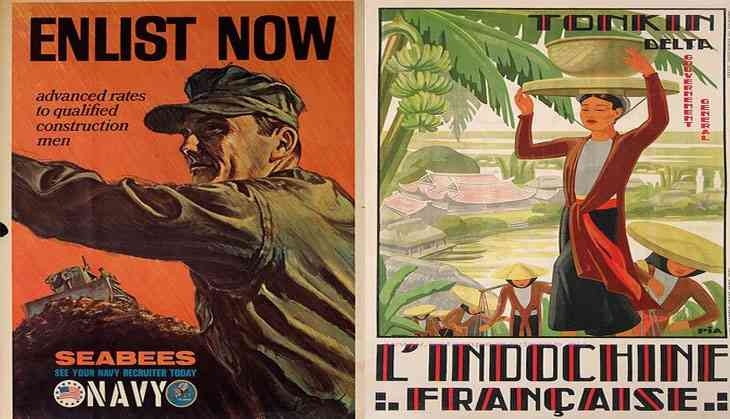Vietnam's disappearing vintage signs are pop culture remnants of a bygone era

Since the turn of the 20th century, Vietnam has seen tremendous urban changes. Saigon became Ho Chi Minh City – a colonial, then communist, centre evolving into a dynamic modern metropolis. But relics of its past remain. ![]()
While working in Saigon between 2010 and 2015, I was captivated by rare glimpses of handmade shop signs, the pop culture remnants of a bygone era.
Vintage zinc and a tasty noodle bowl
In 1952, a street cart sold noodles on Tran Cao Van, a tree-lined street in what is now a prime location in Saigon. The owner made his living on that street corner for nearly 30 years. By the time Vietnam had won its wars, gained independence and settled (somewhat) into its new regime, the noodle-maker had upgraded from his cart to a nearby shop.
He gave his restaurant the name of the street he had always worked on so that loyal customers would find him, and labelled the spot with large-scale, three-dimensional zinc signage.
In the years to come, as Vietnamese who had fled conflict returned home for a visit, the restaurant’s reputation for tasty broth and a comforting bowl of pho grew internationally.
Today, the owner’s adopted daughter, Hong, now in her 60s, runs Pho Cao Van. She practically grew up in the place, which has hardly changed since it first opened. Its two 1970s-era artisanal signs still hang, one inside the restaurant and one on the façade.
Next to the hand-welded 3-D lettering outside is a beverage-sponsored plastic sign put up, Hong told me, in 1975, after the the fall of Saigon. The city was awash in uncertainty, so as a precaution against theft or plundering the family hid their expensive zinc sign inside until things calmed down. They substituted it with the plastic sign, which has stayed there since.
As it happened, the electric light above the shop’s entrance was indeed seized soon after the sign was moved indoors. To this day, old metal signs are sold for cash in Vietnam, which is one reason why wartime signs are now so scarce.
Vinh Loi’s watch shop
An even older golden metal sign used to decorate the entrance to Vinh Loi’s watch repair shop in Cholon, Ho Chi Minh City’s Chinatown. Today, all that remains of the metal letters created around 1964 is an outline of dirt and blackened drill holes on the storefront.
When asked about the marks, the owner seems delighted to inform me that the lettering was stolen three years ago. He believes that the letters were taken because they were old and valuable, which seems like a badge of honour for Vinh.
Inside the shop, a golden row of Chinese characters on the back wall spell out the words “technology of watches and clocks”. They were installed nearly half a century ago, at the same time as the erstwhile outdoor sign. Bilingual signs are still common in the area where Chinese settlers made their home in the late 1700s.
Generally, there is little appreciation of the heritage value of old signs, so the thief who stole Vinh’s lettering is unlikely to have prized the sign as an antique, as the shop owner likes to think. It seems more plausible that it was sold as scrap metal: the bronzed colour of the piece could have led a thief to hope for a high price.
The bodybuilder who painted
Another sign that has disappeared – sold, not stolen – is a hand-painted placard for a community gym, featuring none other than Arnold Schwarzenegger.
Phu Sy Hue, the gym’s first bodybuilding master, has been training weightlifters here since 1975, the year that the Vietnam-American War ended. It was around 1980, Phu recalls, that a hand–painted sign with a folk portrait of Schwarzenegger was first put up on the roadside.
At the time, Vietnam did not receive tourists or have much contact with the world outside its borders, so the portrayal of the former Hollywood star is unusual. The sign was painted for the club by one of its members, Tri, a practising bodybuilder who had studied painting, though he was never a commercial signwriter.
That profession has become so rare since the advent of digital printing in the late 1990s that few shops would now be able to commission such a sign.
Some time in the early 1990s, an American tourist encountered the sign and, evidently impressed by the strange finding, bought it on the spot for a sum that, given the income disparity in the two countries, seemed like a good deal to both parties.
Tri immediately started painting a replacement sign (the blue-hued lead image of this article), which hung on the gym’s entrance gate from the early 1990s till around 2013. It was then removed during construction work and left in the parking lot by the weight-training room. Again a foreigner with hard currency stumbled upon it and offered to buy it.
The interest in these depictions is testament to the power of celebrities, spreading American pop culture far and wide. Since the fitness club’s renovation in 2015, a charmless digitally printed sign now advertises the bodybuilding facilities.
HCMC in the 21st century
Vietnam’s urban landscape is changing fast, but some things stay the same: the amateur bodybuilder and signmaker now runs a traditional medicine shop not far from the gym, and though Phu is now in his 60s, he continues to train.
The phenomenal development of Ho Chi Minh City in the 21st century, documented by Erik Harms among others, has no doubt caused much vintage signage to disappear. As academics and the art world debate what merits collection and preservation in museums and archives, city centres – in Vietnam as elsewhere – continue to reflect society’s changing tastes.
Research shows that the main reasons factory-made shop signs have become the norm across Vietnam are their lower cost, fast delivery and, above all, ease of acquisition. Today, signwriters are even harder to find in Ho Chi Minh City than its nostalgia-inducing vintage signage.
Cristina Nualart, Researcher of Contemporary Art, Universidad Complutense de Madrid
This article was originally published on The Conversation. Read the original article.
First published: 21 April 2017, 17:48 IST





![BJP's Kapil Mishra recreates Shankar Mahadevan’s ‘Breathless’ song to highlight Delhi pollution [WATCH] BJP's Kapil Mishra recreates Shankar Mahadevan’s ‘Breathless’ song to highlight Delhi pollution [WATCH]](http://images.catchnews.com/upload/2022/11/03/kapil-mishra_240884_300x172.png)

![Anupam Kher shares pictures of his toned body on 67th birthday [MUST SEE] Anupam Kher shares pictures of his toned body on 67th birthday [MUST SEE]](http://images.catchnews.com/upload/2022/03/07/Anupam_kher_231145_300x172.jpg)






